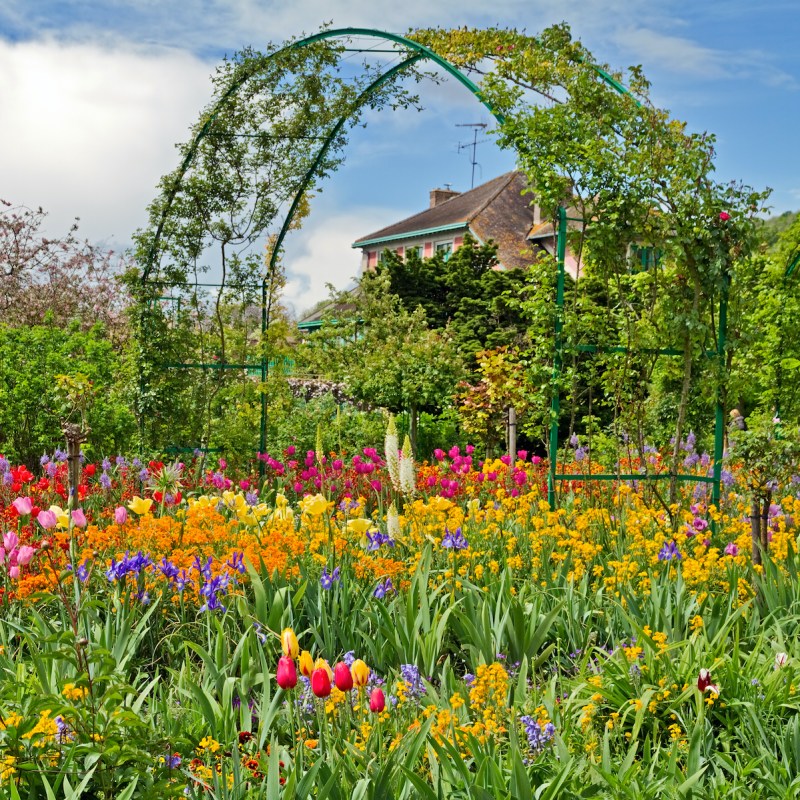
You probably recall that Claude Monet was a pioneer of the French artistic movement known as Impressionism. You may even be familiar with his paintings, including Stacks of Wheat and Water Lilies.
Videos by TravelAwaits
But did you know you can visit Monet’s house and his prized gardens at Giverny, France, where he lived for 43 years? Although the house and gardens were closed due to the COVID-19 pandemic, they have now slowly begun to reopen to visitors.
So how do the gardens look?
“Blooming and competing for attention, irises in all hues from deep purple to light blue look like they were painted by Monet himself,” an Associated Press article explains. “Other flowers add dots of red and yellow to the tableau, as [Monet] did with his brushes.”
Artistic Inspiration
Giverny is about an hour away from Paris by train. After Monet bought the property in 1883, he began to transform a marshy area behind the house into a water garden — complete with a Japanese-style wood bridge. He also painstakingly created a garden — known as Clos Normand — noted for its use of flowers with varying perspectives, symmetries, and colors.
“Adding both exotic and domestic plantings, including his famous water lilies, the artist created the garden that would be one of his principal subjects for the rest of his life,” the Art Institute of Chicago explains. “Water Lily Pond was among the 18 similar versions of the motif that he made in 1899 to 1900; their common theme was the mingling of the lilies with reflections of other vegetation on the pool’s surface.”
Monet and his family lived at Giverny from 1883 to 1926. Today, it’s popular with art lovers from around the world who travel to see the gardens and Monet’s paintings. Indeed, each year, it receives more than 500,000 visitors, according to the not-for-profit Giverny organization.
A Cautious Reopening
France has had some of the strictest COVID-19 restrictions and closures in Europe. Now, as the number of people who have been vaccinated for COVID-19 steadily climbs and the number of new infections declines, the country is easing restrictions as part of a phased reopening.
In Giverny, this means visitors can once again see Monet’s paintings and the gardens. While they can still tour the grounds, only 200 visitors will be allowed each hour to limit capacity. They also will only be able to eat outside.
That said, gardeners have been working non-stop to make sure the gardens don’t disappoint. That work has paid off.
“In his prized water garden where Monet, enchanted, spent hours contemplating the reflections of light and color, the wisteria that he had planted is blooming on the Japanese-style footbridge, in a delicate violet cascade into the pond,” the Associated Press article reports. “The scarlet of the azaleas is eye-searingly vivid. The frogs croak choruses of approval.”
Know Before You Go
It isn’t quite time to start booking airfare for France. French President Emmanuel Macron has laid out a reopening plan which will allow “foreign tourists” with a “health pass” to enter France beginning June 9, 2021. However, what’s not clear — at least not yet, anyway — is whether or not travelers from the U.S. will be included among the foreign tourists allowed to enter. Furthermore, what exactly a health pass is or how it will work has not been explained either.
There is good news though. While waiting for France to begin reopening, you can take a virtual tour of Monet’s house at Giverny as well as learn more about Monet’s paintings and the gardens. You can also consider Sharon Odegaard’s account of how to spend a day in Giverny here.
